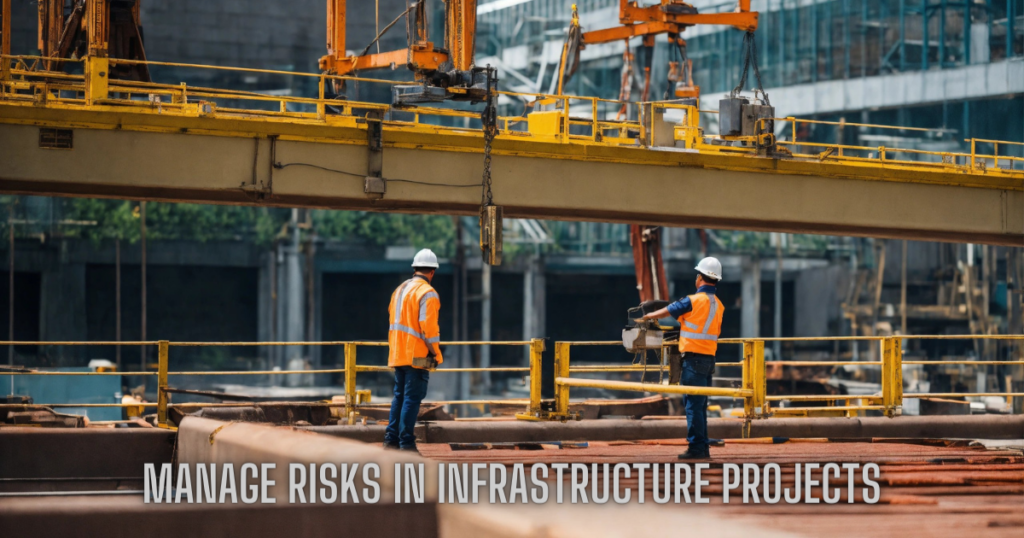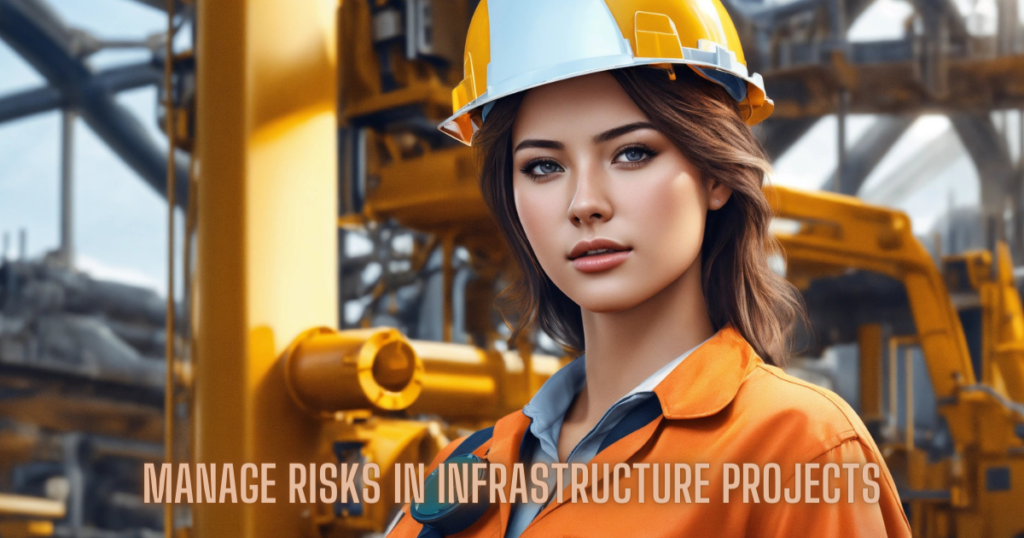Risks in Infrastructure Projects: Infrastructure projects are large-scale, complex, and long-term endeavors that aim to provide essential services and facilities for economic and social development. However, they also entail various types of risks that can affect their feasibility, performance, and sustainability. These risks need to be identified, assessed, and managed throughout the project life cycle, from planning and design to construction and operation. Here are some of the major categories of risks and some possible ways to mitigate them:

Risks in Infrastructure Projects
Technology and Design Risks
These are the risks related to the technical specifications, engineering standards, and design choices of the project. They can result in cost overruns, delays, defects, or failures if the project is not adequately planned, tested, or implemented. Some examples of technology and design risks are:
- Inadequate or inaccurate feasibility studies, cost estimates, or environmental impact assessments
- Unproven or complex technologies that require high levels of expertise, maintenance, or adaptation
- Design changes or enhancements that require additional funding, resources, or approvals
- Regulatory or contractual non-compliance or disputes
To manage these risks, the project owners and developers should:
- Conduct thorough and realistic studies and assessments before initiating the project
- Choose appropriate and proven technologies that suit the project objectives, scope, and context
- Establish clear and flexible design criteria and specifications that allow for adjustments and contingencies
- Ensure compliance with relevant laws, standards, and contracts and resolve any issues or conflicts promptly and fairly
Construction Risks-Risks in Infrastructure Projects
These are the risks related to the physical execution and delivery of the project. They can arise from the complexity, duration, or uncertainty of the construction process, as well as from the performance and reliability of the contractors, subcontractors, suppliers, and workers involved. Some examples of construction risks are:
- Delays or disruptions due to weather, accidents, strikes, or force majeure events
- Cost escalations or shortages due to inflation, currency fluctuations, or market changes
- Quality issues or defects due to poor workmanship, materials, or supervision
- Safety hazards or accidents that cause injuries, fatalities, or environmental damage
To manage these risks, the project owners and developers should:
- Select qualified and experienced contractors, subcontractors, and suppliers that have a track record of delivering similar projects
- Monitor and supervise the construction activities and progress regularly and rigorously
- Implement effective quality control and assurance systems and procedures
- Enforce strict safety and environmental standards and practices

Operational Risks
These are the risks related to the ongoing operation and maintenance of the project. They can affect the availability, reliability, or efficiency of the project’s products or services, as well as the revenue and profitability of the project. Some examples of operational risks are: Risks in Infrastructure Projects
- Operational failures or breakdowns due to technical malfunctions, human errors, or vandalism
- Resource or supply chain shortages or disruptions due to scarcity, competition, or geopolitics
- Market or demand fluctuations or uncertainties due to changes in consumer preferences, behavior, or income
- Regulatory or contractual changes or challenges that affect the tariffs, subsidies, or incentives of the project
To manage these risks, the project owners and operators should:
- Implement preventive and corrective maintenance programs and plans
- Secure adequate and diversified sources and suppliers of resources and inputs
- Conduct regular market research and analysis to anticipate and respond to customer needs and expectations
- Negotiate and maintain favorable and stable regulatory and contractual arrangements and terms
Country Risks
These are the risks related to the political, economic, social, and legal environment of the country or region where the project is located or operates. They can affect the stability, security, or viability of the project, as well as the rights and interests of the project stakeholders. Some examples of country risks are:
- Political instability or violence that disrupts or threatens the project’s operations or assets
- Economic recession or crisis that reduces the project’s revenue or increases its costs
- Social unrest or conflict that affects the project’s workforce, customers, or communities
- Legal or institutional weaknesses or corruption that impairs the project’s governance, compliance, or dispute resolution
To manage these risks, the project owners and operators should:
- Assess and monitor the country’s political, economic, social, and legal situation and trends
- Develop and implement contingency and crisis management plans and strategies
- Engage and collaborate with the relevant government agencies, authorities, and regulators
- Support and participate in the country’s social and environmental development and initiatives
Conclusion-Risks in Infrastructure Projects
Infrastructure projects are essential for the development and well-being of societies, but they also entail significant and diverse risks that need to be carefully and proactively managed. By identifying, assessing, and mitigating the technology and design, construction, operational, and country risks, the project owners and developers can enhance the chances of delivering successful and sustainable infrastructure projects.
People also ask-Risks in Infrastructure Projects
- What are the risks involved in IT infrastructure management?
- Risks in IT infrastructure management can include cybersecurity threats, data breaches, system downtime, hardware failures, software vulnerabilities, and inadequate disaster recovery plans. Additionally, issues such as insufficient capacity planning and poor network design can pose risks to the overall efficiency of IT infrastructure.
- What are the key risks of implementing this project and how are you going to manage them?
- The key risks of implementing a project can vary depending on the nature of the project. Common risks include budget overruns, timeline delays, scope changes, and inadequate stakeholder communication. To manage these risks, a comprehensive risk management plan should be established, including regular monitoring, contingency plans, effective communication channels, and collaboration with all stakeholders.
- How do you mitigate infrastructure risk?
- Mitigating infrastructure risk involves several strategies:
- Conduct thorough risk assessments before project initiation.
- Implement robust contingency plans for potential issues.
- Regularly monitor and evaluate the project’s progress.
- Establish clear communication channels among team members.
- Utilize proven technologies and design criteria.
- Adhere to relevant laws, standards, and contracts.
- Mitigating infrastructure risk involves several strategies:
- What is infrastructure risk management example?
- An example of infrastructure risk management is in the construction of a new bridge. The risks may include delays due to unforeseen weather conditions, cost escalations due to fluctuations in material prices, or design changes requiring additional approvals. To manage these risks, the project team would develop contingency plans, closely monitor construction activities, and maintain open communication with stakeholders to address potential issues promptly.
Disclaimer
This article has been created on the basis of internal data, information available publicly, and other reliable sources to be believed. The article may also include information which are the personal views/opinions of the authors. The information includes in this article is for general, educational, and awareness purposes only and is not a full disclosure of every material fact.
All the information on this website – World Virtual CFO – is published in good faith and for general information purposes only. World Virtual CFO does not make any warranties about the completeness, reliability, and accuracy of this information. These are my views for only information purposes. Any action you take upon the information you find on this website (World Virtual CFO), is strictly at your own risk. World Virtual CFO will not be liable for any losses and/or damages in connection with using our website. For details please refer to our disclaimer page.
Dr. Dinesh Sharma is an award-winning CFO and AI strategist with over two decades of experience in financial leadership, digital transformation, and business optimization. As the founder of multiple niche platforms—including WorldVirtualCFO.com—he empowers professionals and organizations with strategic insights, system structuring, and innovative tools for sustainable growth. His blogs and e-books blend precision with vision, making complex financial and technological concepts accessible and actionable.